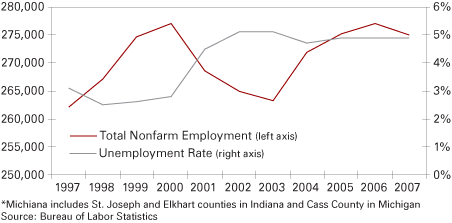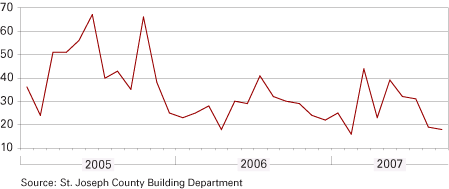South Bend–Mishawaka and Elkhart–Goshen
Director, Bureau of Business and Economic Research; Assistant Professor of Economics, School of Business and Economics, Indiana University South Bend
The economic slowdown experienced across the United States also plagued north-central Indiana. The metropolitan areas of South Bend–Mishawaka (St. Joseph County, Indiana, and Cass County, Michigan) and Elkhart–Goshen (Elkhart County, Indiana) faced a sluggish economy in 2007. The year started slowly and remained slow-moving until an upturn in the third quarter. While uncertainties about the local economy persist, the outlook for 2008 looks marginally better than the past year as the national economy gains momentum.
Employment
Figure 1 shows the overall slowdown in the region's employment growth. Annual unemployment rates in the region have remained steady since 2005. Unemployment rates dropped significantly in the first half of 2007, rose during the early summer, but turned downward again beginning in August. Continuing the trend that began in 2006, the unemployment rate in the South Bend–Mishawaka metro exceeded the national and state averages, while the unemployment rate in the Elkhart–Goshen metro remained below the national and state averages through much of the past year. In 2007, for the first time since 2003, total nonfarm employment fell from the previous year, signaling weakening labor demand and slower economic activity in the region.
Figure 1
Total Nonfarm Employment and Unemployment Rate in the Michiana Region,* 1997 to 2007

Table 1 reports employment data by industry for the region's metropolitan areas. Approximately 280,000 people are employed in nonfarm sectors across the region, with employment being about 16,000 people higher in the South Bend–Mishawaka metro. From September 2006 to September 2007, total nonfarm employment decreased by less than 0.1 percent, with a loss of 800 jobs in the Elkhart–Goshen metro and a gain of 300 jobs in the South Bend–Mishawaka metro.
Table 1
Employment by Industry, September 2007
| Industry | South Bend–Mishawaka Metro |
Elkhart–Goshen Metro |
Combined |
|||
Employment |
Change Since September 2006 |
Employment |
Change Since September 2006 |
Employment |
Change Since September 2006 |
|
| Total Nonfarm | 148,000 | 300 | 132,000 | -800 | 280,000 | -500 |
| Manufacturing | 20,900 | 200 | 62,100 | -1,500 | 83,000 | -1,300 |
| Trade, Transportation, and Utilities | 29,000 | 500 | 19,200 | 100 | 48,200 | 600 |
| Educational and Health Services | 32,800 | 200 | 11,100 | -100 | 43,900 | 100 |
| Government | 17,600 | -300 | 9,700 | 0 | 27,300 | -300 |
| Professional and Business Services | 13,200 | -200 | 9,300 | 300 | 22,500 | 100 |
| Leisure and Hospitality | 12,600 | 0 | 7,800 | 300 | 20,400 | 300 |
| Natural Resources, Mining, and Construction | 6,700 | 0 | 4,900 | 100 | 11,600 | 100 |
| Financial Services | 7,400 | 0 | 3,200 | 0 | 10,600 | 0 |
| Other Services | 5,600 | -100 | 3,900 | 0 | 9,500 | -100 |
| Information | 2,200 | 0 | 800 | 0 | 3,000 | 0 |
Source: Bureau of Labor Statistics
Manufacturing employment fell by 1,300 jobs due in part to a sluggish RV market in the Elkhart–Goshen metro, where 1,500 manufacturing jobs were lost. Manufacturing employment will likely remain uncertain in the year ahead as the RV market stays flat and local producers and suppliers continue to feel the side effects from the domestic auto industry's downturn.
Non-manufacturing employment saw more positive changes. Sectors gaining the most jobs were trade, transportation, and utilities in the South Bend–Mishawaka metro, professional and business services in the Elkhart–Goshen metro, leisure and hospitality in Elkhart–Goshen, and educational and health services in South Bend–Mishawaka. Sizeable job losses occurred in manufacturing and government across the region. Government and professional and business services lost jobs in the South Bend–Mishawaka metro, while manufacturing and education and health services suffered losses in the Elkhart–Goshen metro. Many services—including financial services—remained stagnant in 2007, likely due to the sluggish national economy and struggling financial markets. Employment in services and trade will likely improve in 2008 as interest rates fall, spending improves, and financial markets stabilize.
Wages
The average weekly wage rose only 1.7 percent from the first quarter of 2006 to the first quarter of 2007 in St. Joseph and Elkhart counties. This marked a slowdown from the previous year that saw wages rise more than 6 percent in St. Joseph County and more than 10 percent in Elkhart County due to inflationary pressures. Wage growth varied by industry. Manufacturing wages fell 0.1 percent. Wages rose 5 percent in transportation and warehousing and finance and insurance, 4.2 percent in retail, and 2.6 percent in health care and social services. Expected slower inflation in 2008 will continue the slow growth in wages over the coming year.
Housing
Residential construction, measured by the number of new single-dwelling housing permits issued in St. Joseph County, remained soft in 2007 as in 2006. From January 2007 to September 2007, 247 new housing permits were issued, compared to 256 during the same period in 2006 (see Figure 2). That is in stark contrast to the 403 permits issued during the same period in 2005. The continued slowdown in new housing indicates the Michiana market has continued to struggle with weak demand, falling housing prices, growing inventories of existing homes, and tougher credit markets. As financial markets stabilize and interest rates improve, 2008 should see improvement in local real estate markets.
Figure 2
Single-Family Residential Building Permits in St. Joseph County, 2005 to 2007

Summary
In 2007, the Michiana region's economy was sluggish: flat employment, relatively stable unemployment rates, rising wages, and continued slow real estate markets. The outlook for 2008 shows signs of modest improvement, with the region seeing expanded production in some manufacturing and non-manufacturing sectors, higher employment, slowing growth in wages, and more active real estate markets.
Also in this Issue…
- Outlook for 2008
- The International Economy
- The U.S. Economy
- Financial Forecast
- Housing
- Indiana Agriculture
- Indiana
- Anderson
- Bloomington
- Columbus
- Evansville
- Fort Wayne
- Gary
- Indianapolis-Carmel
- Kokomo
- Louisville
- Muncie
- Richmond
- South Bend-Mishawaka and Elkhart-Goshen
- Terre Haute
- Return to Table of Contents



